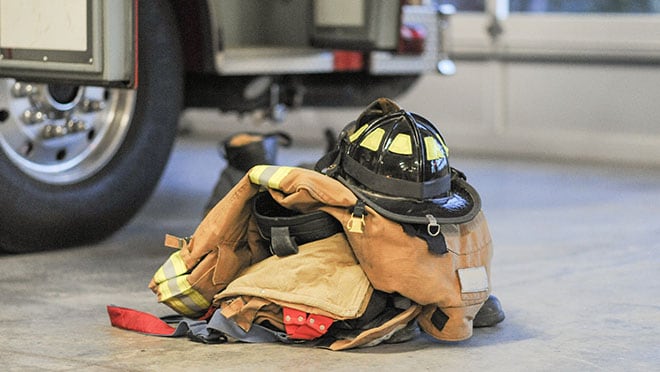Key points
- NIOSH firefighter safety and health work is represented in all 50 U.S. states and Washington, D.C.
- The Center was established to provide a central point for engaging with the broad spectrum of research and service NIOSH conducts around firefighters.
- Partner involvement is key to our success.

Overview
The NIOSH Center for Firefighter Safety, Health, and Well-being provides a central point for firefighters and other fire-service organizations to engage with the broad scope of NIOSH research and services.
Firefighters are vital to the safety of our communities and to reducing the risk of adverse events. However, their jobs can put their own safety and health at risk. Beyond injuries and deaths occurring while on duty, structural and wildland firefighters are at risk of cancer and other illnesses.
Protecting firefighters' safety and health is a top priority for NIOSH. NIOSH has decades of experience conducting investigations and research on firefighter safety and health. In addition, as the threat from structural and wildland fires grows both firefighters and other workers face risks from fire-related exposures, such as smoke inhalation, post-fire clean-up activities, and hazardous materials.
The Center promotes fast identification and prevention of new and emerging hazards, while providing a single access point to improve coordination of activities.

How NIOSH protects firefighters
Services
NIOSH offers a range of vital services to enhance firefighter safety and health:
- National Firefighter Registry for Cancer
- NIOSH Respirator Approval Program
- Health Hazard Evaluation Program
- World Trade Center Health Program
- Fire Fighter Fatality Investigation and Prevention Program
- Emergency Response Support
Cancer Prevention
NIOSH has a variety of activities and research to understand and reduce the risk of cancer in the fire industry, including the NFR, the largest effort ever undertaken to understand and reduce the risk of cancer among U.S. firefighters.
Research
NIOSH conducts research to enhance the health and safety of structural and wildland firefighters. By assessing exposures related to materials burned, fire conditions, and substances encountered such PFAS in firefighting foam, as well as ways to prevent injury and illnesses, NIOSH continues to be at the forefront of firefighter safety and health research.
Personal Protective Equipment (PPE)
NIOSH evaluates the safety of PPE for structural and wildland firefighters—including respirators and turnout gear—through comprehensive research, evaluations, and the NIOSH Respirator Approval Program, safeguarding the health and safety of all responders.
Partnerships
NIOSH collaborates with federal agencies, researchers, fire-service leaders, and organizations to better understand the safety and health needs of firefighters and maximize the impact of NIOSH research and activities.
Resources
NIOSH develops resources and tools to support firefighters and first responders in performing their duties safely and effectively in hazardous environments.
New and emerging issues
NIOSH works to identify and prevent new and emerging hazards in the fire service earlier and faster. In addition to the research and services listed above, NIOSH is addressing these emerging issues:
- Electric vehicle fires
- Hazardous exposures, including PFAS in firefighting foam and turnout gear
- Line-of-duty deaths
- Marine rescue and firefighting
- Protecting first responders during public health threats
- Wildland firefighters safety, health, and well-being
- Wildland urban interface
What we've accomplished
NIOSH firefighter safety and health work is represented across the United States. Some highlights include:
- Fatality investigations 750+
- Health hazard evaluations 85+
- Research and other communication products 1,400+
- Respirator approvals 10,000+
- 9/11 responders who receive healthcare, including 17,000 FDNY firefighters 88,000+
Partnerships
NIOSH works closely with other federal agencies, researchers, and fire-service leaders and organizations to improve firefighter safety and health. Some of the ways NIOSH collaborates with partners include:
- Serving as subject matter experts on National Fire Protection Association and other consensus standard setting committees.
- Collaborating on research projects.
- Developing prevention resources and interventions for fire departments, firefighters, and partner organizations.
- Funding specialized firefighter health and safety training delivered by the International Association of Fire Fighters.
- Maintaining partnerships to identify and address the leading needs and emerging issues facing the fire services.
- Coordinating with manufacturers and National Fire Protection Association third party certification bodies on issuance of NIOSH CBRN SCBA approvals.
Interested parties and partners
Federal
- Department of the Interior
- Environmental Protection Agency
- Fire Administration
- Forest Service
- National Interagency Fire Center
- Occupational Safety and Health Administration
Alliances
- Science to the Station: A Health & Wellness Alliance
- Women's Fire Alliance
Associations
- Fire Department Safety Officers Association
- International Association of Arson Investigators
- International Association of Fire Chiefs
- International Association of Fire Fighters
- National Association of Hispanic Firefighters
- National Fire Protection Association
Other groups
- Congressional Fire Research Institute
- Center for Public Safety Excellence
- Firefighter Cancer Support Network
- First Responder Center for Excellence
- Interagency Board for Emergency Preparedness and Response
- National Fallen Firefighters Foundation
- National Volunteer Fire Council
- National Wildfire Coordinating Group
- North American Fire Training Directors
- Underwriters Laboratories, Fire Safety Research Institute
- Urban Fire Forum of the Metropolitan Fire Chiefs
- Wildland Fire Leadership Council
